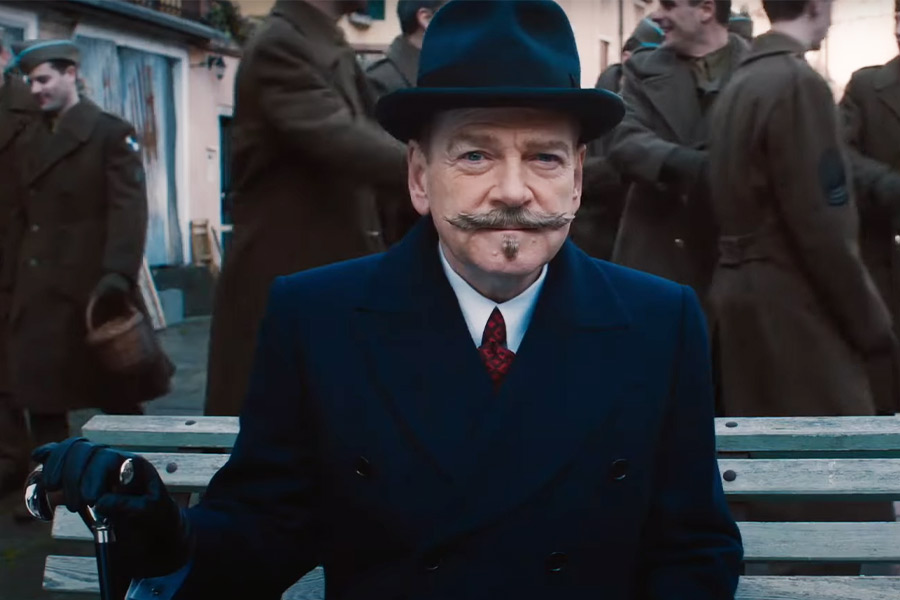I went into Kenneth Branagh’s A Haunting in Venice with a lot of trepidation. His previous outings as Agatha Christie’s famous detective — Murder on the Orient Express and Death on the Nile — had left me cold. Despite the lavish look and A-list cast, the former offered very little pay-off in terms of thrills, ending up almost facetious and overblown. The latter got off to an inventive start depicting a young Hercule Poirot in the trenches of World War I and the origin story of his trademark moustache, which is the movie I would have liked to see, instead of the adaptation of Christie that it became.
I am not sure if it was my lowered expectations or the film’s inherent merits that made me take to it. I am inclined to think it’s the latter. For one, screenwriter Michael Green takes apart the original novel almost in its entirety and then proceeds to redesign the material, creatively and tellingly.
Christie’s novel, Hallowe’en Party (that she dedicated to P.G. Wodehouse), was published in 1969 and set in Woodleigh Commons, England. Branagh and his team shift the action to Venice and transport the narrative to 1947. Both decisions work admirably. The former providing the film with a stunning visual palette, relentlessly dark; the latter imbuing it with aspects of the era’s post-war melancholy that comes through in the characters of both Poirot and a couple of other important players, including a precocious child, which gives the narrative a pathos.
In the process, an essentially old-world murder mystery becomes a psychological horror film, complete with jump scares and sound effects that are likely to make you spill the coffee in your cup if you were having one, as I was. The tangential commentary it makes on the depravities of war and men adds a layer to it that often makes it better than the source material. Purists and Christie aficionados might scoff and protest, but I have always believed that filmmakers must reinvent and do so boldly for narratives like this to work. What’s the point of just filming the page as our adaptations of detective stories most often do?
A Haunting in Venice begins with crime novelist Ariadne Oliver (Tina Fey) tracking down Hercule Poirot — one of the few elements from the original the screenplay retains — in an apartment in Venice, having retired from detective work. However, even here, as the narrative develops, Oliver’s character is given a twist that is non-existent in the original and that makes her much less likeable than Christie’s original character.
Oliver hustles Poirot to attend a Halloween party where he is introduced to a celebrity medium, Joyce Reynolds (Michelle Yeoh). A séance is to take place where Reynolds intends to communicate with the spirit of Alicia Drake (Rowan Robinson), the teenage daughter of former opera singer Rowena Drake (Kelly Reilly), who died violently and mysteriously. (In the original, Joyce Reynolds is the 13-year-old girl who brags about having watched a murder, which is what gets her killed, with Poirot entering the narrative after the party, and after the murder has been committed.) Here, Joyce’s murder immediately follows the séance which Poirot, eternally sceptical about both ‘ghosts and God’, debunks as a fraud.
Over the next hour, we are introduced to more murders in the gothic palazzo as it thunders and rains outside and the characters are locked in by Poirot (almost like they are in Christie’s The Mousetrap and And Then There Were None) whose faith and skill will be tested to the hilt. There’s a wartime surgeon Leslie Ferrier (Jamie Dornan) who has not got over the horrors of what he endured in the war (much like Poirot himself); his son Leopold (Jude Hill) who communicates with the dead spirits residing in the palazzo (you almost expect him to say, ‘I see dead people’) and who understands his father’s ‘battle fatigue’; Rowena’s housekeeper Olga Seminoff (Camille Cottin); Alicia’s ex-boyfriend who moved to greener pastures, Maxime Gerard (Kyle Allen); and Mrs Reynolds’s assistants, the siblings Desdemona and Nicholas Holland (Emma Laird and Ali Khan), refugees from the war who have watched the first half of Meet Me in St Louise with American troops on a ‘sheet’, and are fascinated enough to want passage money to travel to Missouri. There’s also an ancient legend, The Children’s Vendetta, hovering over the house and the narrative like a curse.
Of course Poirot will solve the case and that will entail that favourite trope of murder mysteries — the detective gathering everyone around and expounding on the whats, whys and hows. What works here is the way it is done and the way what has gone before is presented, with the cinematography creating a veritable picture of decay and doom. It is almost claustrophobic and despite a couple of aspects that didn’t work for me — a fisticuff between Maxime and Leslie that seems to go on forever — it holds to the end, with Branagh’s Poirot making quite an impression with his world-weary and morally exhausted depiction of the Belgian detective.
But giving away the end in a review is not done, and though the narrative here has a mind of its own, even if viewers have read Christie’s novel there’s something that they can look forward to. Screenwriter Green, who also scripted Death on the Nile and the Blade Runner sequel, makes A Haunting in Venice a beast of its own. In fact Green has written the introduction to the movie tie-in edition of the novel which he begins by saying that his film murders the book the reader might be holding. But that’s the kind of murder even Poirot might approve of, because it brings to life the film.
(Shantanu Ray Chaudhuri is a film and music buff, editor, publisher, film critic and writer)










